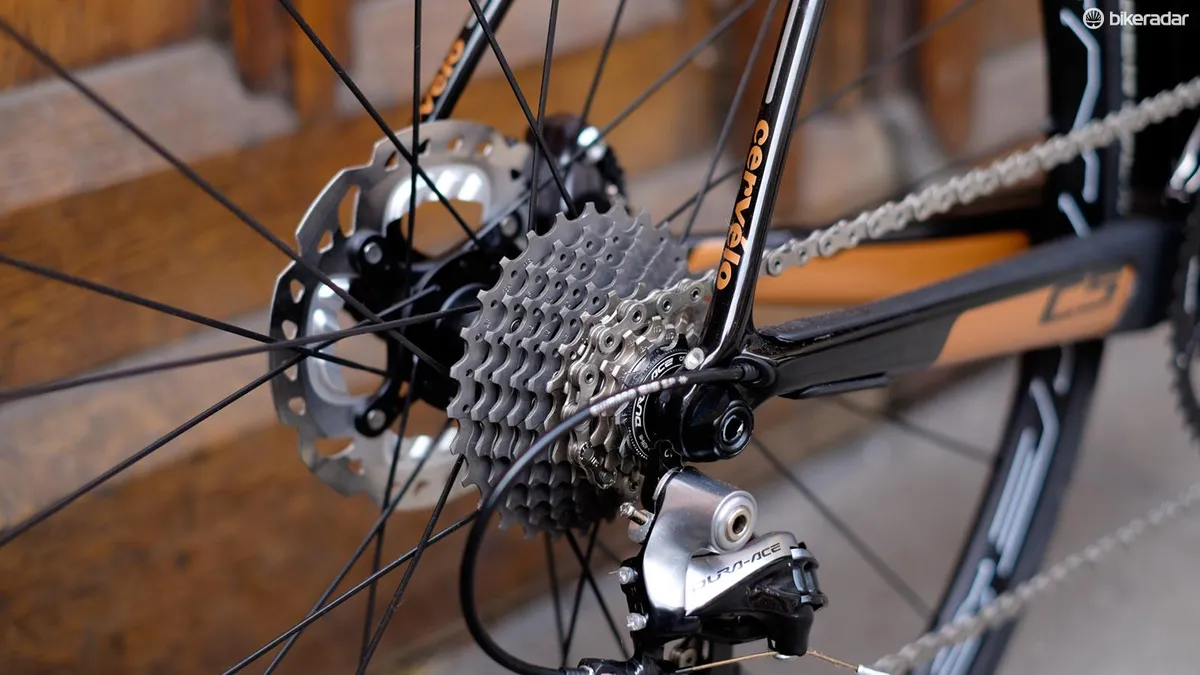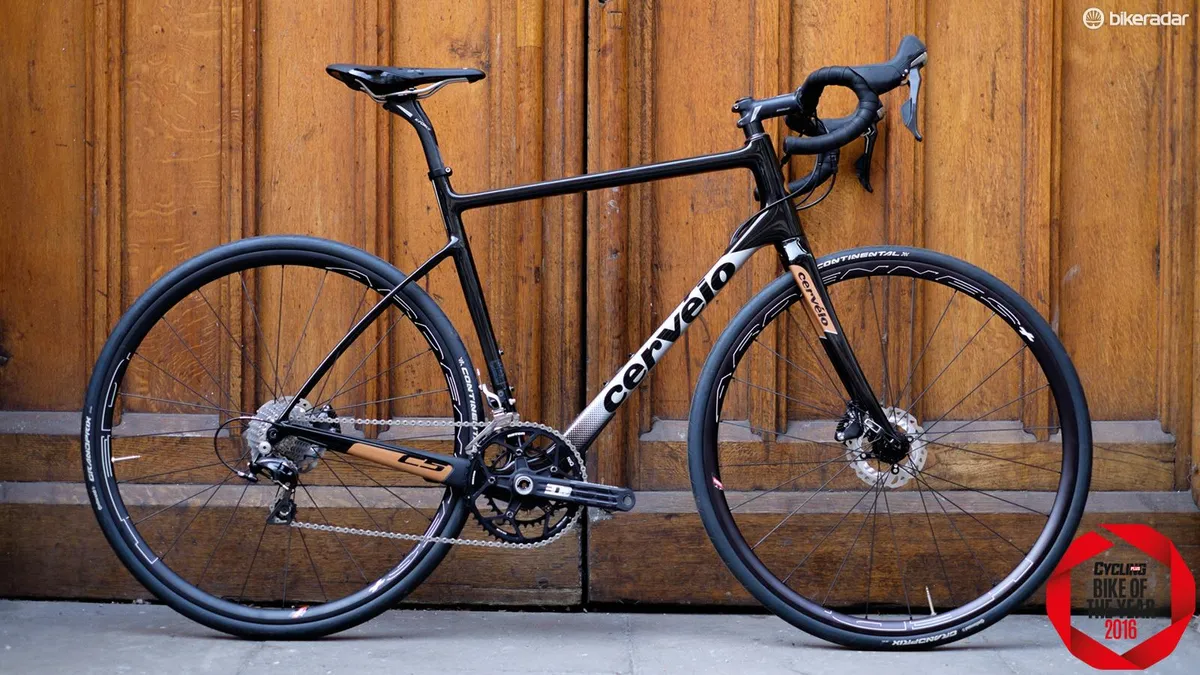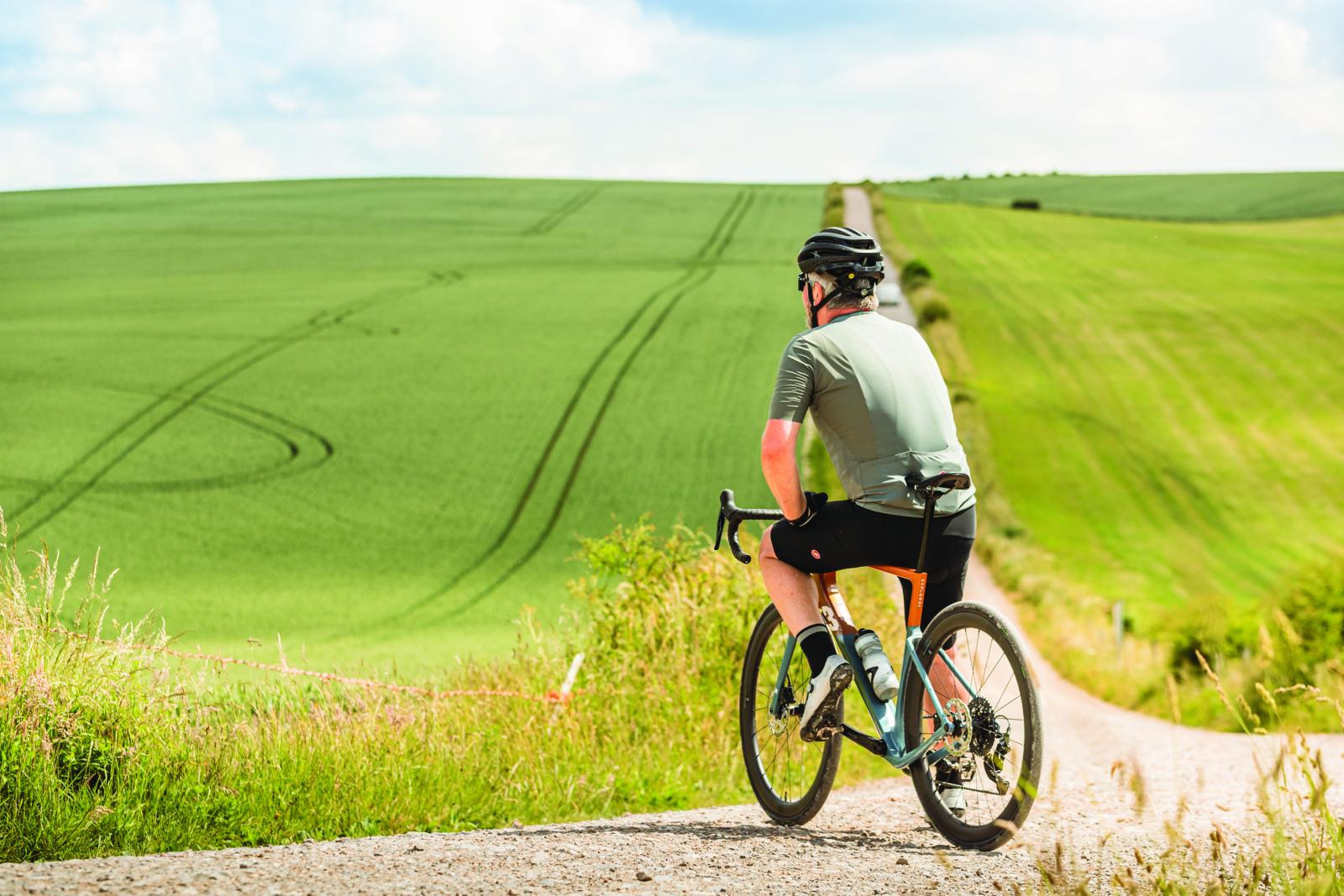Cervélo has a long history of race bikes – but the new C5 is no race machine. WIth a swept-out fork, a down tube bashguard, wide clinchers and disc brakes, the C5 represents a new category for the Canadian brand that made its name with aero race rockets.
We spent three days over the back end of 2015 riding the Canadian brand’s new endurance bike around Napa Valley, California, on a variety of surfaces. The impression we got was strong enough to propel the C5 into our sister title Cycling Plus's annual Bike of the Year longlist, from where it ended up scooping the magazine's 'best debut' award.
Shape shifting
The frame features a standard 73-degree seat angle, but up front the head tube has been slackened down to 71, and the fork offset increased to 53mm over the R series' standard 43mm. The stack is also up from 580mm to 595mm for a 56cm size and the reach is 5mm shorter down from 387mm to 382mm. That should give the C a more relaxed riding position, with the bigger fork offset aiding handling stability on rougher surfaces.
Because the C series is designed around using larger tires, Cervélo has increased bottom bracket drop. It’s now up to 75mm from 68mm for comparable 56cm R- and C-series bikes. The lower BB also influences the stack number (the vertical distance from the crank axis to the top middle point of the head tube).

When you get onboard it's immediately apparent that the C feels every inch a Cervélo. It's still blessed with the same righteous urgency that we’ve enjoyed on every bike we’ve ridden from the brand dating back to the all-alloy aero goodness of the original Soloist.
The ride position is a little taller up front (by around 22mm on the 58cm) but because the BB drop is greater the head tube hasn’t had to be extended to create this; in fact the fork height adds the 22mm so the C5's front end looks relatively normal. It’s a small point (the visual element that is) but a bike's looks play an important part in is saleability.
Usually comfort means a weight penalty, but the C5 is light; my 58cm test bike weighed 7kg/15.3lb. In fact, Cervélo claims it’s the lightest endurance disc frame available, with the 56cm weighing a claimed 840g (including the alloy hardware for the thru-axles and so on). My larger 58cm frame was a little over 30g more – anything under a kilo for thru axles and discs is impressive.
Serious cornering prowess
Where the C series is at its most impressive is on fast sweeping descents with plenty of wide-open corners – just the sort of thing you’ll find on the big Californian roads we tested it on. The frame's ability to absorb bumps and road noise is amongst the finest we’ve tried – make no mistake, this is right up their with class leaders like Cannondale’s Synapse, BMC’s GF01 and Giant's Defy.

The lower BB seems to shift your centre of gravity, enabling some serious velocities and monster cornering prowess. The long wheelbase and increased fork offset (53mm) mean the C5’s stable too, and its ability to hold a line mid-corner on scarred and deteriorated surfaces is huge.
The 28mm wide tires help, as you can run the pressure down a few psi and get the C5 onto some really rough surfaces. Not that – according to Cervélo anyway – this is specifically a ‘gravel’ machine, though as mentioned above it does feature a bashguard on the down tube, plus a seriously big bonded-on rubberised chainstay protector.
Adaptability also looks to be a major consideration of the design: the rear seatstays are as asymmetric as any we’ve seen, to allow installation of all current calipers and rotor sizes up to 160mm.

The frame's compliant nature is matched by the long offset fork, which offers fore-aft bump absorption that you can feel. We found ourselves hunting for potholes to pitch into, just to experience the way in which the 'Project California' handbuilt fork smothers the hand-stinging smash you usually get from a carbon item. It's impressive stuff – it can get a little unsettled over a washboard of ruts, but we were only taking those on because it set the bar higher than most (no pun intended). On other bikes we’d have backed off much, much sooner.
Well-appointed spec
Componentry wise the C5 is as you’d expect, very well appointed. The Dura-Ace / BR-RS805 combination offers flawless shifting and great braking. We like that Cervélo has adopted thru-axles front and rear, meaning rotor alignment was always spot-on and the brakes remained noise and rub free throughout the three days of testing (in some pretty inclement weather too). The rear thru-axles hardware is particularly clever, with both the wheel and rear derailleur locating from the axle threads, ensuring perfect alignment every time.

The FSA carbon cockpit is a great match for the front end. The well-shaped bar has a compliant feel, and the compact drop should suit most. For those looking for a lower position, a switch to a standard drop bar would be a decent option.
The big 28mm Contis are solid in all conditions, but we did find them a little more puncture-prone than on previous experience – something to do with the thorns found in Napa maybe? These are shod onto the wide, disc-only variant of HED’s excellent alloy Ardennes Plus wheelset. The rim profile is widened to 25mm (over the standard Ardennes' 23mm) yet they're still relatively light, tipping the scales at just over 1600g per pair.
The only thing I really felt at odds with on the C5 was the saddle. Fizik’s Antares isn’t inherently a bad perch and it has plenty of fans, but this channeled ‘VS’ version has a defined ridge on both sides of the pressure relief channel. For this tester at least, that created two uncomfortable pressure points, and only shifting my weight right back away from the ridges offered any relief.
In all, the C5 (and its cheaper sibling, the C3) won’t necessarily appeal to existing Cervélo fans. With the C5 prioritizing comfort and stability over agility and ultra-light weight, the pseudo-racing brigade may well feel shortchanged. However, by maximizing comfort, compliance and handling, Cervélo created a bike that deserves a much wider audience. This is the all the bike that most people need; it remains to be seen if it’s the bike that most people want.





